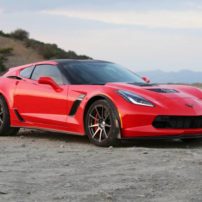Political correctness has obligated every auto manufacturer to have at least one electric vehicle (EV) in its lineup. The Cadillac ELR is General Mot ors’ (GM) luxury entry into the fray — it’s second. While most automakers sell either battery only, plug-in vehicles like the Nissan LEAF, or gas-electric hybrids like the Toyota Prius, only GM is offering two extended-range electric vehicles (EREVs) – the Chevy Volt and now the Cadillac ELR. The ELR, a plug-in luxury sport coupe, is based on the Volt EREV platform and powertrain.
ors’ (GM) luxury entry into the fray — it’s second. While most automakers sell either battery only, plug-in vehicles like the Nissan LEAF, or gas-electric hybrids like the Toyota Prius, only GM is offering two extended-range electric vehicles (EREVs) – the Chevy Volt and now the Cadillac ELR. The ELR, a plug-in luxury sport coupe, is based on the Volt EREV platform and powertrain.
performance, and much more visual appeal than the Volt, not to mention the luxurious interior, and abundance of lavish features you expect from Cadillac. On the downside, it’s basically a two-seater featuring a small back seat and a nearly $80,000 sticker price ($77,690 as tested).
Cadillac began building its brand image around the Art and Science theme — luxury and technology — with the 1999 Evoq concept sports car, which evolved into the Cadillac XLR — basically a Corvette in edgy Cadillac trim. It was followed by the game changing CTS sports sedan, which eschewed the jellybean look with its distinctive, sharply chiseled lines. It was a high-stakes gamble that paid off big for GM, reigniting a declining brand into something as hip as anything European or Japanese. Lincoln should have been so bold.
Both luxury and technology have evolved since then, and the ELR takes that theme to new heights. Boasting a Cadillac-style leather interior, handling-enhancing Continuous Damping Control with selectable ride modes, and Regeneration-on-Demand — using steering-wheel paddles to slow down the ELR while regenerating energy back into the battery — and a lot of other technology not available on the Volt.
Due to the high battery cost, purely electric vehicles are expensive, plus having the dual disadvantages of limited range and long recharge times. There’s also “range anxiety” – a term GM has trademarked — meaning the fear of running out of juice before you can recharge. Parallel hybrids, which efficiently blend battery electric and gasoline engine power, cost less than EVs but more than conventional vehicles.
The advantage of an EREV is those first 30-40 miles are on battery — using no gas. Short commutes to work and overnight recharging can theoretically avoid using gasoline at all. However, if the battery runs down, the fuel-efficient engine will take you as far as a tank of gas can — eliminating range anxiety. There’s no need to recharge until the next convenient opportunity. The major disadvantage is the high cost of a large, expensive battery, dual propulsion systems, and the hardware and software that make it all work.
Model Lineup: The Cadillac ELR comes in just one model and trim level. The highlight of the leather-lined cabin is the Cadillac User Experience (CUE) – an eight-inch tablet-like (tap/flick/swipe/spread) color LCD touch-screen infotainment and navigation system, with multi-configurable displays. Also standard are 16-way adjustable heated front and fold-down rear seats; a kickass Bose 10-speaker premium audio system; Keyless Access and pushbutton start with Adaptive Remote Start; Advanced Continuous Damping Control suspension; Regeneration-on-Demand; 20-inch all-season tires on chrome alloy wheels; front and rear LED lighting; and 10 air bags.
The limited options are 20-way adjustable seats in semi-aniline leather; Full-Speed-Range Adaptive Cruise Control with Auto Collision Preparation; Intellibeam Headlamps; Crystal Red Tintcoat paint; and a Luxury Package that adds Rear Cross Traffic and Side Blind Zone Alerts; and 20-inch ult ra-bright machined aluminum wheels.
ra-bright machined aluminum wheels.
Walkaround: The ELR practically mirrors the 2011 Cadillac Converj concept coupe. The intense wedge profile features Cadillac’s two-door coupe’s signature — chiseled creases, rounded edges, forcefully raked front and rear glass, and big 20-inch wheels pushed out to the corners. Headlamps and taillights are finely detailed vertical slits housing LEDs, and door handles hide in recesses behind the doors. The battery charge port resides on the driver’s-side front fender, while green pulsing lights on the outside mirrors flash while charging, going dark when finished.
Interior: The plush interior is world-class — luxurious, quiet, and well-crafted with chrome and wood accents. A leather/suede microfiber trimmed steering wheel and suede microfiber headliner enhance the leather-trimmed seats, while choreographed LED accent lighting adds nighttime ambiance. There’s even a power-assisted console cup holder cover.
The center of the dash is home to the aforementioned 8-inch color touch screen that houses CUE, and runs all of the climate, audio, and navigation, functions via voice command  or a finger swipe.
or a finger swipe.
Instrumentation is customizable, with classic circular speedometer or modern digital readouts — with or without energy usage data. Pushing the power button lights up a multifaceted display detailing battery state-of-charge (SOC), EV range, and matching fuel-level and fuel range.
Under The Hood: Like the Volt, the ELR utilizes a 1.4-liter four-cylinder engine driving a 5.5-kW generator. It powers the drive motor when the 16.5-kWh lithium-ion battery pack is exhausted. That powerplant pushes out 295 lb.-ft. of torque, and the propulsion system lets it dig deep into its battery for stronger performance on demand.
The engine powers an electric generator — not the drive wheels — most of the time. Both run on just battery power for the first 30-40 miles. Then an 84-horse 1.4-liter gas four-banger fires up to drive a 55 kW generator to keep them going. Total system output is 162 horses and 295 pound-feet of torque.
Cadillac claims the electric-only range is 37 miles on the battery (depending on weather conditions, terrain, and how you drive), plus another 303 miles after the gas engine starts, for a total range of 340 miles.
Behind The Wheel: Driving the Cadillac ELR on a wide range of terrains, we found it to be a charming ride. Doing the 0-60 drill in about 8 seconds, it’s quick enough to be fun, with handling surprisingly good on winding two-lane blacktops — despite its almost 4,000-pound curb weight.
We were able to average just about 33 miles on electric over a combination of terrain. Driving uphill depletes the battery quickly, while coasting downhill replenishes it. Driving in Sport mode for a feisty romp on some twisty two-lane blacktops on the Olympic Peninsula, then harder still in the shadow of Mt. Walker along the adjoining curvy roads on the back side of Hood Canal, using the Regeneration-on-Demand paddles (instead of the brakes) to slow for curves, was some serious fun.
Whines: Rear visibility is somewhat restricted due to the wedge shape and steeply raked glass.
Bottom Line: If you like edgy styling, sporty driving dynamics, with the ability to run on battery power a lot of the time — and can afford a sexy-looking, feature-laden luxury sport coupe that’s both fuel efficient and fun, the ELR is the ride for you.




















Comments